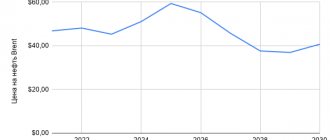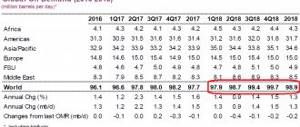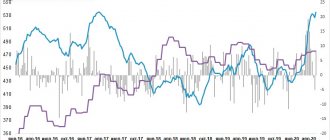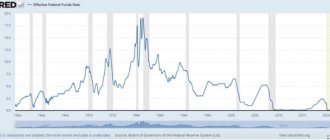A spoonful of the nuclear deal in a barrel of post-Covid oil: the market is waiting for an Iranian comeback
Oil prices fell for the third day in a row on Thursday after diplomats said progress was being made on lifting sanctions on Iran on the way to restarting the country's 2015 multilateral nuclear deal. The market froze in anticipation of the return of Iranian “big oil” to it as a result of the lifting of the embargo on the export of black gold from the Islamic Republic introduced by former US President Donald Trump in 2021 and still in effect.
Brent oil fell in price today, May 20, by 81 cents, or 1.2 percent, to $65.85 per barrel. U.S. West Texas Intermediate crude fell 77 cents, or 1.2%, to $62.59.
Iranian President Hassan Rouhani earlier on Thursday said in a televised speech that progress had been made during the talks in Vienna and the hour was near when the United States would lift its sanctions on the petrochemical industry, shipping, insurance and the Central Bank of Iran, Reuters reports.
But senior diplomats from Britain, France and Germany sounded a note of caution last Wednesday, saying that while there had been "some tangible progress in defining the contours of a final deal" in the Austrian capital, success was not guaranteed.
Indian refiners and at least one European refinery are reviewing their crude purchases to make room for Iranian crude in the second half of this year as they await the lifting of U.S. sanctions, company officials and trade sources said.
“Given that global oil demand growth will remain steady until the end of this year, and in 2022 the OPEC+ group of producers will be in a relatively comfortable position to cope with increased production in Iran, an imbalance in the oil market is not expected,” PVM analysts note (headquarters in London).
Concerns about demand prospects in Asia also led to lower prices. Almost two-thirds of people tested in India were found to be infected with the Covid-19 coronavirus infection, the British news agency notes.
Speculation that the U.S. Federal Reserve could at some point begin tightening policies that would impact economic growth prospects has prompted some investors to reduce exposure to oil and other commodities. Crude oil inventories in the United States rose by 1.3 million barrels last week, compared with analysts' expectations in a Reuters poll of a rise of 1.6 million barrels. Gasoline inventories fell 2 million barrels, compared with a forecast of 886,000 barrels. Gasoline supply, an indicator of demand for the strategic energy carrier, increased by 5% to 9.2 million barrels per day.
“Our attention is drawn to the rapid recovery in demand for petroleum products in the United States, which is now very close to 2019 levels,” analysts said.
Iran is ready to increase oil production after the arrival in the White House of Joe Biden , who previously advocated the return of the United States to the Joint Comprehensive Plan of Action (JCPOA) on Tehran’s 2015 nuclear program (nuclear deal).
“We remain ready to dramatically increase oil production,” Iranian President Hassan Rouhani said in December 2021. As the head of government recalled then (the posts of president and prime minister in Iran are combined), after the conclusion of the nuclear deal and the lifting of international and unilateral sanctions from Iran, the country was able to increase oil sales abroad to 2.5 million barrels per day. Earlier, officials in Tehran indicated that last year Iran sold an average of 600 to 700 thousand barrels of oil per day due to the American embargo on the supply of black gold from Iran to foreign markets.
The prospects for the return of Iranian oil to the market have collapsed quotes
Moscow, May 19 - Neftegaz.RU news agency.
Oil prices are falling today after Brent crude broke through the $70/barrel mark the day before. On May 18, 2021, oil prices ended trading lower, but during the session prices soared to 2-year highs. Brent oil rose to $70.24/barrel, WTI - $67.02/barrel. However, in general, following the results of trading on May 18, the cost of Brent oil futures for July on the London ICE Futures exchange fell by 1.08%, to $68.71 per barrel. WTI crude oil futures for July fell 1.18% to $65.50/barrel in electronic trading on the New York Mercantile Exchange (NYMEX).
On May 19, 2021, oil prices continue to go down. By 11:00 Moscow time, the price of July Brent futures on ICE Futures fell by 1.30% to $67.82 per barrel. WTI oil futures for July fell 1.40% to $64.58/bbl in NYMEX electronic trading.
Natural gas prices are also falling. On May 18, 2021, June natural gas futures fell 3.12% to $3.012/MMBtu in NYMEX electronic trading. By 11:00 am on May 19, prices were down 0.66% to $2.992/MMBtu.
The sharp rise in oil prices on May 18 was the result of market optimism regarding the prospects of lifting coronavirus restrictions in the United States and Europe. Also, the positive dynamics of oil prices was supported by the weak US dollar. However, the growth was interrupted by news of progress in negotiations on the Iranian nuclear program, the success of which could lead to the return of Iranian oil to the market. May 18, 201, Permanent Representative of the Russian Federation to international organizations in Vienna M. Ulyanov:
- said that negotiators to return the US and Iran to the Joint Comprehensive Plan of Action (JCPOA) on the Iranian nuclear program have made significant progress.
- announced an important announcement on this issue, expected on May 19th.
Let us recall that in May 2021, US President D. Trump decided to unilaterally withdraw from the JCPOA and restore tough sanctions against Iran.
A year later, Iran announced a gradual reduction in its obligations under the JCPOA, abandoning restrictions on nuclear research, centrifuges, and the level of uranium enrichment. Even before his inauguration, US President D. Biden announced that he intends to return the United States to the nuclear deal with Iran. According to S&P Global Platts, a return to the JCPOA could lead to an increase in oil production in Iran to 3.9 million barrels per day in 2022. Iran is already increasing oil production, increasing the volume in April 2021 by 130 thousand barrels. day compared to March, to the highest level since May 2021 of 2.43 million barrels per day. Iranian oil is mainly exported to China, despite US pressure. Investors are also awaiting the release of official statistics on oil and fuel reserves in the United States from the US Energy Information Administration (EIA). Statistics from the American Petroleum Institute (API) on May 18 showed that commercial oil reserves in the United States for the week ending May 14 increased by 620 thousand barrels. At the same time, gasoline and distillate inventories fell sharply - by 2.8 million barrels. and by 2.6 million barrels. accordingly, which was largely the result of the blockage of the Colonial Pipeline due to a cyber attack. Experts expect that official data will show a decrease in oil reserves by 2.9 million barrels, an increase in gasoline reserves by 600 thousand barrels. and a decrease in distillate inventories by 200 thousand barrels.
US stock indices ended trading lower after US Treasury Secretary D. Yellen announced that the administration intends to raise taxes on corporations and on wealthy Americans as part of an infrastructure spending plan. The Dow Jones Industrial Average fell 0.78% to 34,060.66 points. The Standard & Poor's 500 lost 0.85% to 4,127.83 points. The Nasdaq Composite fell 0.56% to 13,303.64 points.
Bitcoin falls due to regulatory risks. According to Reuters, China has banned financial institutions and payment companies from providing services related to cryptocurrency transactions, and also warned investors against speculative crypto trading. This dealt a blow to investors who had been betting on digital assets gaining mainstream status. On May 19, 2021, by 11:00 am, Bitcoin fell by 10.86% to $40,292.3/bitcoin.
The ruble is growing against the US dollar and the euro. On May 19, 2021, by 11:00 Moscow time, the ruble rose in price against the US dollar by 0.06%, to 73.6703 rubles/dollar. USA. Against the euro, the ruble rose by 0.07% to 90.0427 rubles/euro.
Why is it too early to buy oil companies?
The oil and gas sector has lagged behind the Moscow Exchange index for the past two months. This was fundamentally justified - for all chips, except for Gazprom, we long ago changed BUY to HOLD, because they are trading with small upsides to fundamental estimates.
In today's post you will learn why oil companies have been uninterested in buying for the past two months
Arguments why oil producing companies are not interesting:
- They lose in potential upside 1-2 years ahead to other cyclical sectors where there is a global deficit. In oil, the market is balanced only thanks to the OPEC+ deal, and if not for the cartel, prices would be much lower. That is, even if an oil company is trading upside, other sectors have higher upsides, and it makes more sense to participate in them.
- Current prices already reflect positive expectations for oil at $60/barrel
- We see potential for rising oil supply expectations and falling demand expectations
- Inflation and GDP growth rates are expected to peak in the summer, after which a slowdown is expected. All commodity companies, and especially the oil sector, are sensitive to economic growth rates.
The oil industry has not been interested in buying for a long time
The Moscow Exchange index (blue) versus the index of oil and gas companies (orange) has been falling since mid-March:
On March 13, as part of our subscription, we talked about how oil chips had approached their fundamental estimates:
It is important that Gazprom was left on BUY, and we continue to make money on it (the rate on gas is another matter).
Arguments why oil producing companies are not interesting:
- They lose in potential upside 1-2 years ahead to other cyclical sectors where there is a global deficit. In oil, the market is balanced only thanks to the OPEC+ deal, and if not for the cartel, prices would be much lower. That is, even if an oil company is trading upside, other sectors have higher upsides, and it makes more sense to participate in them.
- Current prices already reflect positive expectations for oil at $60/barrel
- We see potential for rising oil supply expectations and do not see potential for demand growth
India – the forecasts already contain positive expectations
One of the biggest variables in oil demand is India due to the problems it is experiencing with the coronavirus (Europe and the US have reached a stable trajectory in terms of demand for petroleum products).
The EIA now forecasts oil demand in India without taking into account the lockdown, which has lasted since April due to rising infections. By the way, restrictions have helped reduce the spread of infection, and from the beginning of June New Delhi (the capital of India) will lift restrictions if the number of infections per day continues to decline.
Source: EIA forecast
In any case, the lifting of restrictions in India will not be immediate, so the current global forecast for oil demand may be lowered by 0.3-0.5 mbs:
Another big variable is demand from aviation. To return to pre-coronavirus levels, global air travel must resume, not just domestic travel. I have not seen public expectations of such a recovery in 2021; expert estimates most often speak of recovery only by 2023.
Global oil supply could rise due to Iran
Oil supply expectations are as follows:
- EIA maintains US production forecast at 11.84 mbs (down 0.02 mbs, which is insignificant)
- OPEC lowered US production expectations to 11.04 mbps (down 0.28 mbps). We believe this is due to low drilling activity in the US, which does not allow a return to previous production levels.
- The US is considering lifting sanctions on Iran. Meanwhile, Iran is already producing 2.5 mbs (before sanctions it was 3.8 mbs, that is, this is potentially +1.3 mbs within a few months). Iranian presidential elections will be held on June 18, and given the ongoing negotiations in Vienna, we believe that agreement on a deal will be reached before the elections.
Since May, OPEC began to increase production volumes as planned. However, the planned growth was only 600 thousand b/d (Saudis + other countries), while the actual growth of exports from these countries increased by 1 million b/d (according to the Petro Logistics tanker tracker for the first half of May).
It is possible that by the end of May we will see an underfulfillment of the OPEC+ deal and I suspect that this may be due to the dissatisfaction of the participants that they may lose their market share in favor of Iran.
The next OPEC meeting will be on May 31. Firstly, they will probably discuss options for action if Iranian volumes return to the market. Secondly, it allows us to see adjusted demand forecasts to reflect weaker demand in India. Depending on the coordination of OPEC's actions, we will see a gradual or sharp correction in oil prices.
Iran – additional oil supply in the next two weeks
Let's dwell on the topic of Iran in more detail, because... this is the biggest factor in supply growth + potential risk for the stability of the OPEC+ deal.
At the end of April, the prince of Saudi Arabia said that they were striving to build good relations with Iran (this had not happened before; Iran was always considered an enemy of the Saudis). Since the Saudis are allies of the United States, we understand that this is primarily due to the political course of the United States.
After this, information appeared in the media about a secret meeting between high-ranking officials of Saudi Arabia and Iran in Iraq (this meeting was confirmed by Iraqi news sources; there was neither confirmation nor denial from Iran and the Saudis).
There is an opinion in the media that this is due to the Saudis switching from US cooperation to China (Iran is a large oil supplier to China). But as we see the US itself negotiating a nuclear deal and lifting sanctions on Iranian oil, I believe these are signs of progress in reaching agreement on a deal.
As of today, negotiations in Vienna continue despite the fact that Iran set the deadline for reaching agreements at May 21. Obviously, Iran needs a deal, so they are making concessions. There are two weeks left before the presidential elections in Iran, and the current one (Rouhani) needs to reach a deal, otherwise Iran will continue to suffer economically from sanctions, and negotiations with the new president will take an indefinite amount of time.
The market is already pricing in high oil prices
According to our calculations, with oil at $60/barrel on average in 2021, Russian oil producing companies are trading with upsides from 4% to 17% on the horizon of the year. This yield is below the market average, and in order to enter into new longs for oil companies, one must wait for a correction.
By the way, we will discuss exactly when to enter the sector this Thursday at our Strategy Day - this is a large online event that we hold once every three months, where we tell you how to get decent profitability in the coming months: which sectors to buy, share which sectors to cut and why.
Denial of responsibility
- Oil
NOT a hamster! — newsletter for investors
Here we collect the best of what we have written on the topic of the market and current situations in companies for you!
Ready! Soon a newsletter with the most important posts from our team will begin to arrive at the specified address.
Will be left without enrichment
For Russia, as well as for other OPEC+ members, the delay in lifting sanctions on the Iranian oil industry has a lot of advantages. Firstly, our country needs production growth to increase exports, the volumes of which decreased in 2021 by 11.4% - from 266 million to 232 million tons, and in monetary terms - by 40.8%, to $72.3 billion .
Secondly, Iranian oil will not return to Europe and the Asia-Pacific countries - China, South Korea, Japan and India, where it previously successfully competed with Russian oil, which will allow our country, if production increases, to confidently increase supplies to these markets.
Thirdly, sanctions in the current situation of an artificially created oil shortage, due to the OPEC+ deal and production cuts in the US and Canada, will continue to push barrel prices up.
Before the sanctions, Iran produced 4.5-5 million barrels per day, of which a little less than 2 million was used for domestic consumption, and about 2.5-3 million barrels per day were exported, said Alexander Amiragyan, deputy head of the “Energy Economics and Climate” department of the Center for Social Development. . Sanctions against Iran mean the elimination of about 2 million barrels of oil per day for the world market - about 2% of demand. This simplifies the task of balancing the global oil market, and if restrictions are lifted, it will cause an imbalance of supply and demand, which will require an appropriate response from OPEC+, the expert said.
For example, alliance members may be required to further reduce production or at least maintain the current parameters of the deal. Or we will have to negotiate with Iran on its active participation in OPEC+, that is, insist that Tehran does not increase production to the maximum.
Taking into account the difficult relations between Iran and Arab countries, the negotiation process could turn out to be very problematic, emphasized Alexander Kurdin, an expert at the Analytical Center for the Government of the Russian Federation. In his opinion, this is why, in connection with the change of administration in the United States and attempts to return to the “nuclear deal,” Iran should now be included in OPEC+ negotiations and scenarios for the partial return of its production should be assessed.
US sanctions against Iran removed 2 million barrels of oil per day from the market
In the meantime, US restrictions are forcing Iran to reduce oil production better than any OPEC+ deal, says the head of the National Energy Security Fund, Konstantin Simonov. The continuation of the confrontation between Iran and the United States will destabilize the situation throughout the Middle East, but this factor is already familiar and does not play its former significance for oil prices. If Iran returns to the “nuclear deal” and sanctions are lifted, it will demand special conditions for itself in OPEC+, which will have a bad impact on both oil prices and the discipline of implementing the deal within the alliance, Simonov noted.
Prices are on the rise
The price of Brent oil at the auction on November 9 soared by almost 10% (to $43.17 per barrel at 17:40 Moscow time) on news of successful trials of the coronavirus vaccine developed by Pfizer and BioNTech.
COVID-19 and everything connected with it still remains a key factor influencing quotes, said Maria Belova, research director at VYGON Consulting. This situation will continue in the first half of 2021, she believes.
Prices will also be influenced by how successfully the participants in the OPEC+ deal adjust their production volumes to changing demand. In a positive scenario, oil will cost $40–45 per barrel, the expert believes.
Arabian mirages
Photo: REUTERS/Carlo Allegri
However, there is also a negative scenario, according to which, with the arrival of Joe Biden in the White House, prices for black gold will sharply decline, reaching $25 per barrel.
— It is traditionally believed that oil is cheap under Democrats and expensive under Republicans. Although this, of course, is quite conditional,” noted the head of the Alpari IAC, Alexander Razuvaev.
You shouldn’t expect rapid changes in oil prices just from the very fact that the US president has changed, said Artem Deev, head of the analytical department at AMarkets. The market depends on the balance of supply and demand, as well as on specific decisions of politicians that can lead to imbalance, he said.
Arabian mirages
Photo: REUTERS/Abdel Hadi Ramahi
Just such a key factor influencing the price of oil may be Joe Biden’s previously announced intention to lift restrictions on Iran and the conclusion of a nuclear deal with this state. As a result, Iran will return to the oil market with large volumes of raw material production, which will destabilize quotes - they will go down, the expert believes.
In any case, Russia will once again be able to “sit out” cheap oil, believes Alexander Razuvaev. The volume of the National Welfare Fund (NWF) as of November 1 amounted to 13.3 trillion rubles, or 11.7% of the forecast GDP for 2021, which is equivalent to $167.63 billion.
Iran still hopes for a favorable outcome in negotiations with the US
At the end of this week, the deadline that Iran gave to the international community to reach a compromise on the “nuclear deal” expired. However, for now, Tehran is in no hurry to completely deprive the IAEA of access to camera recordings from Iranian nuclear facilities in the hope that the United States will eventually lift its sanctions on Iran.
“The IAEA does not have the right to access camera footage and information from the Atomic Energy Organization of Iran due to the deadline,” Iranian Parliament Chairman Mohammad Bagher Ghalibaf said on Sunday. However, the Iranian Tasnim news agency, citing an official in the secretariat of the Supreme National Security Council, said that it was possible to preserve the camera footage for another month to allow the completion of negotiations in Vienna on the restoration of the “nuclear deal” - the Joint Comprehensive Plan of Action (JCPOA). ), signed in 2015 by Tehran with the five permanent members of the UN Security Council and Germany. This is supposed to demonstrate Iran's "good will".
On Sunday evening, the IAEA reported that the agency's director general, Rafael Grossi, continues consultations with Iran on this topic.
His press conference following the negotiations is scheduled to take place on Monday.
Iran limited the inspection activities of the International Atomic Energy Agency (IAEA) at the end of February in connection with the entry into force of the “Strategic Measure to Lift Sanctions” law. It was Iran's latest attempt to revive the nuclear deal, which had faltered after the United States withdrew from it in 2021, renewing its sanctions policy against Tehran, making it difficult for many countries to work with Iran.
Without waiting for the full launch of the European settlement mechanism, which would allow trade transactions to bypass American sanctions, Tehran in 2021 began to gradually reduce its obligations under the JCPOA. The Strategic Measures Act obliges the government to increase uranium enrichment to 20% and abandon the IAEA's additional protocol requiring enhanced inspections of nuclear facilities unless Tehran is allowed to freely trade oil and conduct financial transactions.
Thus, the agency lost the ability to conduct inspections of any Iranian nuclear facilities at any time it chose.
At the same time, Tehran left a loophole in the hope of still achieving the lifting of sanctions. It was decided that recordings from cameras at nuclear facilities and their list will be stored until May 21, and if a compromise is reached with the international community, Iran will provide them to the IAEA. If the sanctions are not lifted, all records will be erased.
What you need to know about the Iran nuclear deal
Read more
In April, negotiations began in Vienna on the return of Tehran and Washington to the “nuclear deal.” Mediators, including Russia, offered the parties mutual steps towards each other, but Iran, at least in words, is not going to deviate from the principle of first lifting sanctions, then returning to full compliance with the JCPOA. No deal had been reached by May 21, and diplomats feared Iran's decision to delete the camera footage would harm the talks in Vienna. Thus, last week, the permanent representative of the Russian Federation to international organizations in Vienna, Mikhail Ulyanov, noted that the extension of the technical agreement on IAEA inspections in Iran would contribute to the success of the negotiations.
The fifth round of negotiations on the “nuclear deal” will begin tomorrow in Vienna; the previous one ended last Wednesday. In an interview with the Ekho Moskvy radio station, Mikhail Ulyanov expressed hope that the negotiations could end in early June and the JCPOA would be fully restored. He also stressed that there is nothing wrong with the fact that an agreement between Iran and the United States was not reached by May 21.
“We are clearly moving in the right direction, and we have long since crossed the equator in the negotiations. And the feeling is that the final stage will begin next week. I hope that this will happen,” said Mikhail Ulyanov.
According to him, there are now indirect disputes between the Iranians and Americans regarding the scope of sanctions that should be lifted, as well as the steps that Iran needs to take to return to compliance with its obligations. The US proposed three lists: red, green and yellow. Red is non-negotiable, yellow is negotiable, green is something they are ready to remove without any doubt, and, as Mr. Ulyanov noted, it covers the vast majority of economic sanctions, although Iran is still striving for more. And this issue continues to be discussed in Vienna.
Iranian Foreign Minister blames Russia for Iran's problems
Late last week, Iranian President Hassan Rouhani said that Western countries had agreed to the lifting of sanctions “in the areas of oil, petrochemicals, shipping, insurance, the central bank, other banks - they all confirmed this, this issue is completed.” According to him, a basic agreement has been reached, but some questions still remain.
At the same time, US Secretary of State Antony Blinken said that Washington still does not see whether Tehran is ready to return to compliance with the terms of the JCPOA.
“The mediated talks in Vienna clarified what each side must do to return to implementation of the agreement. We know which sanctions need to be lifted because they are incompatible with the deal. But more importantly, Iran knows what it needs to do. What we have not yet seen is whether Iran is ready and willing to do what it must. We don't have an answer to that question yet," he told ABC News. It is no coincidence that the statement by senior diplomats from Great Britain, France and Germany, released last week following the fourth round of negotiations, said that “there will be very difficult issues ahead.”
Nevertheless, no one wants to lose hope for the success of the negotiations. It is important for President Rouhani, whose powers will soon expire, to achieve progress in the near future. Presidential elections will take place in Iran on June 8. And while the president does not set the country's foreign policy, the vote could show how much Iranians continue to believe in promises that dialogue with the West can bring change, as the previous administration promised.
Marianna Belenkaya
Analysts explained why oil will jump to $80 per barrel
MOSCOW, May 22 — PRIME. Oil prices are rising as demand is recovering amid mass vaccinations and the lifting of quarantine measures. In addition, “pandemic” reserves have already dried up, the OPEC+ deal limits production, and in the summer there is a seasonal surge in fuel consumption. RIA Novosti columnist Natalya Dembinskaya talks in her article about what to expect from the global market before the fall.
The Russian stock market grew with the support of oil prices
PRE-CRISIS LEVEL
Last year, the oil industry experienced several waves of decline. A complex of factors had an impact, the main ones being overproduction with a sharp reduction in demand, as well as the pandemic and lockdown. In March last year, oil prices more than doubled to $30 per barrel. However, the most severe restrictions are behind us, vaccination is gaining momentum around the world. Demand for fuel is growing, and the market has recovered from the Covid-19 decline almost completely.
At the end of March, the International Energy Agency (IEA) predicted demand would increase this year to 96.5 million barrels per day and replace about 60 percent of last year's pandemic losses.
Since January, oil prices have risen by 30%, prices are equal to pre-crisis levels. On May 18, Brent prices reached $70 per barrel.
Thomas Varga, analyst at oil brokerage PVM, Fr.
Optimism is also reinforced by statistics from China. There, against the background of economic recovery and an improvement in the epidemiological situation, industrial production in the first four months of 2021 increased by 20.3% compared to the same period last year. And the volume of imported oil refining by independent Chinese refineries increased by 15%.
POSSIBLE SHORTAGE
According to experts, the global oil market is now generally balanced, with demand matching supply.
“OPEC+ decisions to gradually increase production respond to seasonal growth in demand and at the same time take into account that the coronavirus epidemic in India has a negative impact on the global situation,” says Oleg Bogdanov, leading analyst at QBFB.
But the market is still fueled by concerns that long-term supplies will not keep up with the recovery in consumption in the coming years, as international oil companies reduce investment in production due to environmental concerns. “OPEC and other major suppliers, who cut production during the pandemic due to falling demand, are returning seized barrels to the market. But it is unclear whether they have enough spare capacity,” the Financial Times emphasizes.
Another factor is that by the end of April, the fuel reserves accumulated during the epidemic had practically dried up. Slightly more than 20 percent of the “pandemic surplus” remains in developed countries’ storage facilities. If last July there were 249 million barrels, then in February, according to the International Energy Agency (IEA), only 57. This is also the result of the OPEC+ deal.
As the IEA points out, the remaining “pandemic stocks” are almost entirely concentrated in China. And, for example, in American storage facilities there are 1.28 billion, the same as before the crisis.
Experts told how long the current collapse of cryptocurrencies will last
OIL IS OVERRATED
Thus, while the movement to 70 per barrel is largely dictated by positive expectations, oil is fundamentally overvalued. According to the calculations of Meruzhan Dadalyan, Deputy General Director for Private Capital and Investment Management at General Invest, objectively, quotes should now be at the level of $40-50.
Analyst Fr.
According to the General Invest forecast, an increase in OPEC quotas and the lifting of restrictions for Tehran will lower oil to $50-55, closer to the fundamental indicator. If prices consolidate above 70 and global inflation continues to rise, Brent could jump to 90-95. However, this will be a purely speculative effect.
IS A JUMP IN OIL DEMAND ALREADY LOOMING ON THE HORIZON?
Analysts generally believe that the very structure of the market, which promotes rapid oil consumption, and the agreement of leading suppliers to curb production will continue to push prices higher, despite temporary downturns.
According to Rystad Energy, oil demand will increase by six percent year on year in 2021, from 89.6 million barrels per day to 95.4, and in 2022 to 99.4.
And according to one of the largest investment banks in the world, Goldman Sachs, the jump in oil demand that will occur over the next six months will be “the largest on record.” This was explained by the upcoming widespread opening of borders after mass vaccinations against COVID-19.
The bank's report states that "increased interest in travel and accelerating vaccinations in Europe will lead to an unprecedented increase in demand - plus 5.2 million barrels per day." And the conclusion: oil prices will rise to $80 in the summer.
For the Russian economy, 60-70 per barrel is more than acceptable. Maintaining this range is most likely until the end of the third quarter.
Iran will rain oil on the world: Tehran is ready to double production in three months
Iran is beginning preparations to restore oil production amid talks with the United States in Vienna, where Tehran's return to the nuclear agreement and the lifting of sanctions are being discussed. Bloomberg reports, citing Iranian officials, that state-owned oil producer National Iranian Oil Co. (NIOC) has begun technical preparations for fields that were forced to shut down two years ago after the Donald Trump administration imposed an oil embargo on what was once OPEC's third-largest producer.
American sanctions cut oil production in Iran by half - from 3.9 to 1.9 million barrels per day, and reduced exports to almost zero. It fell to a paltry 100,000 barrels a day last summer but began to rise again to reach 500,000 barrels a day after Democrats led by Joe Biden took power in the White House.
In an optimistic scenario, after sanctions are lifted, Iran will be able to practically double production and return it to pre-sanction levels in three months, Bloomberg sources say.
With exports, however, it will be more difficult, admits former NIOC official Mohammed Ali Khatibi: niches have been lost, and it is not a fact that old clients will return.
Realizing this, NIOC began preliminary consultations with old buyers in advance, without waiting for the results of the Vienna negotiations, which promise Iran not only a return to the world oil market, but the unfreezing of international reserves and reconnection to the SWIFT system.
US diplomats have offered Tehran a sweeping deal that would completely lift some of the toughest sanctions imposed by Trump, according to the Associated Press.
Iran may be given back access to the global financial system and the ability to conduct dollar transactions, and in addition, the lifting of sanctions against the oil sector, banks, the Central Bank, industrial and construction companies is being considered.
On May 7, Biden said Iran was showing "seriousness," although the outcome of the talks remained unclear. At the same time, it became known that Iranian diplomats had resumed dialogue with Saudi Arabia for the first time since the severance of diplomatic relations five years ago.
Middle East Eye sources reported that in exchange, the Iranians asked the Saudis for assistance in selling oil on the world market in exchange for ending the conflict in Yemen, from whose territory Saudi Arabia is periodically attacked by Houthi rebels with drones and missiles.
The situation at the Vienna negotiations, meanwhile, became more complicated after the outbreak of the Israeli-Palestinian conflict, in which Iran openly supported the movements. The 15th head of the Iranian Foreign Ministry, Javadd Zarif, refused to go to Vienna for the next round of negotiations in protest against the fact that the Israeli flag was raised on the building of the Austrian government.
If Iran manages to reach a deal, then in 3-6 months it will be able to pump almost 4 million barrels per day, predicts managing director of the consulting company FGE Iman Nasseri.
However, Tehran can increase exports almost immediately, he believes: Iran has accumulated 60 million barrels of crude oil in land-based storage facilities and tankers drifting off the coast.
Of this volume, about 10 million is stored in China and can be quickly sold to local refineries.
The situation around Iranian oil is the most important factor that will move quotes in the coming weeks, says Mikhail Sheibe, commodity market strategist at Sberbank CIB.
Iranian supplies are capable of slowing down the rally that has doubled the Brent price in six months. A delay in the return of Iranian oil to the market, on the contrary, “could provoke a panic wave of purchases from Asian (primarily Chinese) refineries, which are still waiting to see how the situation will develop,” says Scheibe.
Iran is preparing for life without sanctions and for oil expansion
Deputy Prime Minister Alexander Novak is still recording a deficit in the global oil market. Photo by RIA Novosti
Deputy Prime Minister Alexander Novak said that there has been a shortage in the oil market for several months. However, the situation may soon change. This will happen if sanctions are lifted from the Islamic Republic, which Tehran urgently demands in exchange for a return to the Joint Comprehensive Plan of Action (JCPOA) on the Iranian nuclear program. And then, already this year, Iran can double oil production and export about 2–3 million barrels per day (bbl/d). For participants in the OPEC+ deal, this scenario spells trouble. Oil prices may be shaken, but experts hope that the return of Iran is unlikely to undermine the Russian “fiscal rule.”
Iran has started using an oil pipeline from the Gure oil terminal to the port of Jask, which allows it to bypass the Strait of Hormuz, considered the energy artery of the region, RIA Novosti reported on Wednesday with reference to the country's National Oil Company. The pipeline allows the country to transport up to 1 million barrels. oil per day.
On the one hand, previously the President of the Islamic Republic Hassan Rouhani admitted that US anti-Iranian sanctions would not be such a problem for the country if it were less dependent on oil exports. Reducing oil dependence is on the agenda. But on the other hand, Tehran is also exploring new routes for exports, including bypassing the Strait of Hormuz, instability around which could threaten supplies.
A few days earlier, Bloomberg reported that Iran was preparing to increase oil exports amid progress in negotiations with the United States on the possible lifting of restrictions previously imposed on it by Washington. It was clarified that the state-owned National Iranian Oil company is preparing oil fields for production and is consulting with potential clients about supplies.
At the end of April, the Associated Press, citing current and former American officials, reported that the Joseph Biden administration was considering almost completely abandoning some of the toughest sanctions against Iran in an attempt to return to the JCPOA. At the same time, since the beginning of April, meetings of the Joint Commission of Iran and the international “five” (Russia, Great Britain, Germany, China and France) have been held in Vienna, dedicated to the resumption of implementation of the JCPOA - the lifting of Washington’s sanctions on Tehran, the return of the United States to the deal and the fulfillment of Iran’s nuclear obligations.
The official representative of the Ministry of Foreign Affairs of the Islamic Republic, Said Khatibzadeh, stated that no preliminary agreement would be concluded during the negotiations taking place in Vienna “if all Tehran’s conditions are not met.” Earlier this week, Khatibzadeh explained that in Vienna, “three separate working groups are still working on relevant issues, a significant percentage of unresolved issues have been addressed, but some issues require political decisions.”
On Wednesday evening, Bloomberg reported, citing Deputy Iranian Foreign Minister Abbas Araghchi, that the parties involved in negotiations on the return of Iran and the United States to the JCPOA had agreed on the main part of the document.
| The Islamic Republic is preparing its deposits and infrastructure for increased exports of raw materials. Photo from www.nioc.ir |
The Russian permanent representative to international organizations in Vienna, Mikhail Ulyanov, said that the negotiators are close to success.
“The fourth round of negotiations in Vienna has ended. JCPOA participants meeting today about “substantial” progress and that the agreement is “within reach,” he reported on Twitter. According to him, negotiations will resume early next week: “Let’s hope that the fifth round will be the last.” “Iran’s policy is to achieve the effective lifting of all sanctions and their thorough verification as the main conditions for Iran’s compliance with its nuclear obligations,” the IRNA news agency reported this week, citing a statement by 200 members of the Iranian parliament. Moreover, as reported in this statement by the deputies, the negotiations in Vienna show that the United States and European states not only do not yet have a serious will to lift all sanctions, but also seek to impose an agreement on Iran that imposes additional restrictions on nuclear activities, the agency reports.
If the situation develops according to a scenario favorable to the deal and Iran, how will this affect Russia? For example, so far Deputy Prime Minister Alexander Novak has stated that over the past few months we have seen a deficit in the oil market, which is reducing the accumulated balances. But as soon as Iran enters the market with significant volumes of oil, members of the Organization of Petroleum Exporting Countries and the states that have joined them as part of the OPEC+ deal will have to begin difficult negotiations with Tehran.
“Before the introduction of the oil embargo, Iran produced about 5 million barrels per day, and exported 2.5–3 million barrels per day,” recalls deputy head Natalya Milchakova. “If the embargo is lifted, Iran will legally increase oil production within 3-4 months by at least 1.8-2 million barrels per day, and perhaps this will not be the limit.” The buyer of Iranian oil will be primarily China and consumers in Southeast Asia. OPEC experts previously said in a report that for the whole of 2021, Iran's average crude oil production was just under 2 million barrels per day.
“Based on the statement of Iranian Oil Minister Bijan Zanganeh dated December 14, 2021, in 2021 Iran plans to increase supplies of oil and gas condensate to 4.5 million barrels per day. Of this, the country’s budget includes domestic consumption of 2.2 million barrels per day. and exports in the amount of 2.3 million barrels per day,” noted analyst Andrei Maslov. – If a number of sanctions are lifted, Iran will theoretically reach a level of 4.5 million barrels per day. in 2-3 months, which could increase pressure on oil markets.”
“The appearance on the market of an additional 2 million bpd would be an undesirable development of events for both Russia and OPEC+, since the increase in supply (taking into account the fact that since May OPEC+ has set a course for a gradual increase in oil production) may have a negative impact impact on oil prices,” agrees Milchakova.
According to expert estimates, such an increase in supply could quickly lower Brent oil quotes to the area of $58–60 per barrel. On Wednesday, during the day, amid news of a possible increase in supplies from Iran, Brent oil lost about 5% in price, falling below $67 per barrel.
“OPEC+ will negotiate with Iran on restoring its participation in the alliance in order to neutralize the negative consequences for the market, but the negotiations will not be easy,” Milchakova expects. “Iran will probably demand special conditions for itself.”
Although, as analyst Evgeny Mironyuk believes, such a possible increase in production on the horizon before the end of the year “will not be a shock for the oil market.” But he agreed that “OPEC+ members will seek to include Iran in the ‘deal’, which will limit export growth and that in the short term such a development will “reduce the likelihood of Brent prices consolidating above $70 per barrel.” Although, if you believe the previous statements of Alexander Novak, for the Russian oil industry the price range of 45–55 dollars per barrel is “the most optimal.”
But what about the capacity of the Russian Federation budget? “The emergence of another oil supply channel could lead to destabilization of supply and demand. At the moment, the Russian economy as a whole is ready for a drop in oil prices to the level of $50 per barrel, which, however, is still unlikely, says Maslov. “The decline in oil prices if sanctions against Iran are lifted is unlikely to exceed 10%, given the generally optimistic mood in the market.” Thus, as the expert says, this fits into the current cut-off price within the budget rule at $43.3 per barrel, which allows the country to have conditionally excess oil and gas revenues.
Oil is on a roller coaster: what awaits the barrel
— What is happening in the oil market now? Why are there such fluctuations in the price of a barrel?
Milchakova: The week from February 15 to 20 turned out to be very volatile for oil. If at first prices grew rapidly, then over the last three trading days they quickly lost what they had accumulated. There were several reasons for the confident increase in barrel prices to $65 per barrel: in addition to the abnormal cold in Texas and other oil-producing states of the United States, the increase in prices was favored by the registration of an increasing number of vaccines in the world from reputable manufacturers and mass vaccination of the population, which, according to doctors, is bringing the moment closer overcoming the coronavirus pandemic. An additional positive background was created by the forecasts of global investment banks that this year oil prices could rise to $80 against the backdrop of government support in the US and Europe. However, already on February 19, the price of Bent fell by 1.6% - below $63, and WTI fell by 2.46% - to $59. The next day, February 20, barrel prices continued to fall.
Goikhman: Oil prices in recent days have been a roller coaster ride. “Roller coaster” - because there was a rapid rise in prices from $60.2 to $65.5 per barrel of Brent from February 12 to 18, and an equally exciting sharp drop to $62 from February 19. Well, and “American” - because the USA became the reason for this literally chilling “attraction”. After all, it was the icing of fields and unprecedented frosts in Texas that led to a large-scale drop in production in the States. The production reduction reached 4 million barrels, which is almost 40% of all American and about 4% of world production of “black gold”. Cold weather in the United States and Europe not only disrupted energy supplies, but at the same time greatly increased demand for them. In such conditions, the price soared to the peak of a “slide” that the market had not seen since the forgotten prosperous pre-pandemic times of January 2021.
— What factors and in what direction will influence the price of “black gold” in the near future?
Milchakova: Now the time has come for a correction in the oil market. Its factors could be the weakening of frosts in the United States or the announcement by Saudi Arabia that it will unilaterally increase production. The International Energy Agency may issue a report that a quick recovery in the oil market this year should not be expected. The next monthly meeting of OPEC+ member countries will take place in March, which will become the main event for the oil market. By the end of February, Saudi Arabia's position regarding a unilateral increase in oil production will become clearer, and this could cause additional volatility in the market.
Goikhman: Participants in commodity trading are trying to stay ahead of the curve, understanding that the freezes are short-term, in contrast to the general fundamental factors of the market. It looks like the price got scared of itself. The sobering of emotions occurred when the cold weather began to gradually recede. But the OPEC+ meeting, scheduled for March 3-4, is clearly approaching. At high hydrocarbon prices, alliance members may reconsider their agreement and production quotas may increase. In addition, increased production benefits non-OPEC+ countries. Thus, supply will begin to recover, but demand will continue to be limited by panic-pandemic lockdowns in consumer regions. The further fate of oil depends on the decisions of OPEC+, as well as on the scale and success of vaccination, the reality and specific amounts of the allocation of budgetary financial incentives being discussed in the United States.
— Your forecast: how much will oil cost this spring?
Milchakova: OPEC may publish preliminary February data on the implementation of the deal within the framework of production restrictions. There may be more accurate information about rumors that Iraq has been increasing exports secretly from other alliance members, which could lead to a barrel pullback below $60.
Goikhman: With a positive development of the situation, the gradual opening of borders, the restoration of tourism and flights, and the onset of the high driving season, in the summer, quotes may move to $67-70. But any serious negative impact from the pandemic or a significant increase in production could push Brent quotes below $60.











